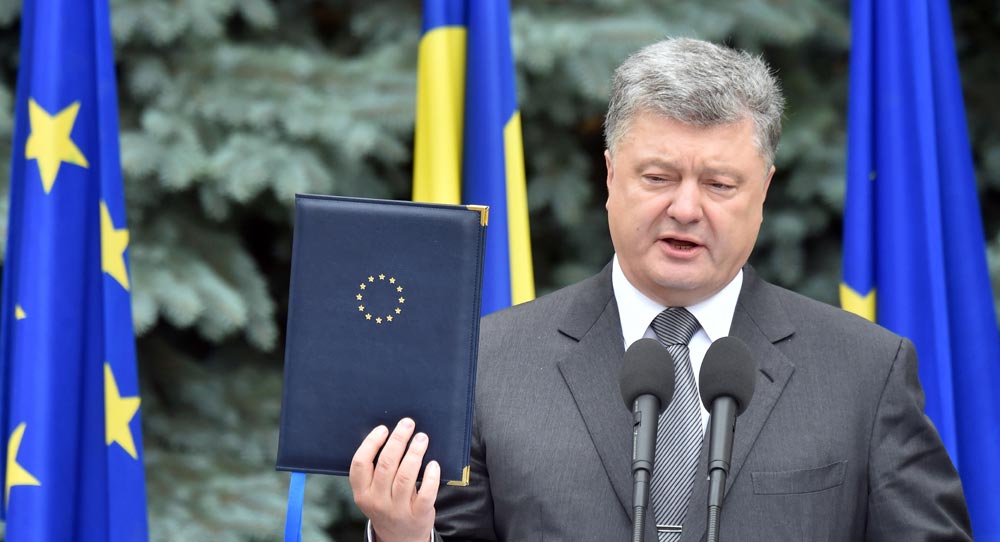On September 1, the EU-Ukraine Association Agreement (AA) finally entered into force. The moment passed rather quickly, not least because parts of the AA had already been provisionally implemented—the political part since November 2014 and the Deep and Comprehensive Free Trade Area (DCFTA) since January 2016. This political fudge resulted from the Dutch referendum halting the ratification of the AA on the EU side as well as fruitless talks with Russia about the economic implications for the Russian market. The AA has been long in the making and its history has been more dramatic than any comparable EU agreement to date. Its official entry into force is therefore politically significant, even if the actual implementation and the resulting tangible benefits for Ukrainian citizens will take time.
The AA stood at the beginning of a series of events that nobody would have deemed possible four years ago. In the autumn of 2013, then Ukrainian president Viktor Yanukovych withdrew his support of the accord at the ratification stage, thereby triggering the Euromaidan protests. In turn, the overthrow of the Yanukovych regime and the installment of an interim government in Kyiv provided the pretext for Russia to militarily intervene in Crimea and pursue the peninsula’s rapid annexation in March 2014. Without Crimea’s annexation, the war in Ukraine’s eastern Donbas region would also have been inconceivable. To be clear, the AA itself is not the cause of the Euromaidan and subsequent events, but it provided the initial trigger for voicing widespread societal discontent with the corrupt Yanukovych regime. It is worth remembering that Yanukovych was as unpopular in the eastern part of Ukraine as in the west.
The AA’s entry into force—in a political climate characterized by war and a serious stand-off between Russia and the West—now carries additional symbolic weight. It underlines the commitment of Ukraine to model itself on the political, legal, and economic principles of EU member states on the one hand and of the EU to pursue closer relations with Ukraine, including a degree of free trade, on the other. The AA covers a wider range of policy areas in much greater detail than similar EU agreements. The level of EU financial assistance and engagement with the so-called “third country” has been unprecedented. Institutionally, the EU has highlighted its commitment by setting up the Ukraine Support Group, a collection of experts from the EU institutions and member states, who coordinate and advise on the reform process.
Although the AA has at times appeared as a goal in itself, it effectively represents a reform agenda for Ukraine. The agreement attaches timelines to the implementation of reforms and the transposition of the EU acquis into national legislation, thereby attempting to carry forward the idea of EU conditionality without the promise of membership. The fight against corruption; judicial, constitutional, and electoral reforms; the improvement of the business climate; and the reform of public administration, including decentralization, have been among the top priorities on the association agenda. Of these, decentralization has progressed the furthest, while progress in other key areas has been patchy and, more recently, slowing. With its emphasis on shared democratic principles and reforms, the AA’s full entry into force should give fresh impetus to strengthen the newly created anticorruption institutions, to remove the controversial extension of the e-declaration of assets to NGOs, and to ensure the transparency of the selection of judges to the Supreme Court. The AA also opens up new channels for political dialogue and cooperation in the energy, transport, and education sectors, among others.
The most tangible incentive related to the AA, visa liberalization, became a reality just ahead of the full agreement’s entry into force. The EU as a bloc is already Ukraine’s main trading partner. The DCFTA removes import duties and other trade restrictions—albeit with limitations and transitional periods in sensitive areas, such as trade in agricultural products—and maps a timetable for the alignment of regulatory standards.
Ukrainian President Petro Poroshenko has been keen to present the AA as a step toward membership negotiations—he sees the country ready for this within a decade. The reaction from EU officials is as noncommittal in this respect, as ever. Some officials, including EU Commission President Jean-Claude Juncker, used the occasion of the AA entering into force to emphasize, yet again, that the agreement marks an important step toward closer relations but that it is not connected to EU membership.
Thus, the AA’s entry into force is primarily a timely two-way reminder: it reminds the EU of its commitment to the reform process and to the integrity of Ukraine. Even more importantly, the AA should serve as a reminder for the Ukrainian political elites that domestic political will is critical for successful reforms—the EU can only support and amplify this domestic momentum. Without a renewed commitment to reforms on the part of the president and the government, in particular with regard to anti-corruption measures and the rule of law, the AA will bring little change to Ukraine.
Gwendolyn Sasse is a non-resident senior fellow at Carnegie Europe and the director of the Centre for East European and International Studies (ZOiS) in Berlin.







.jpg)
